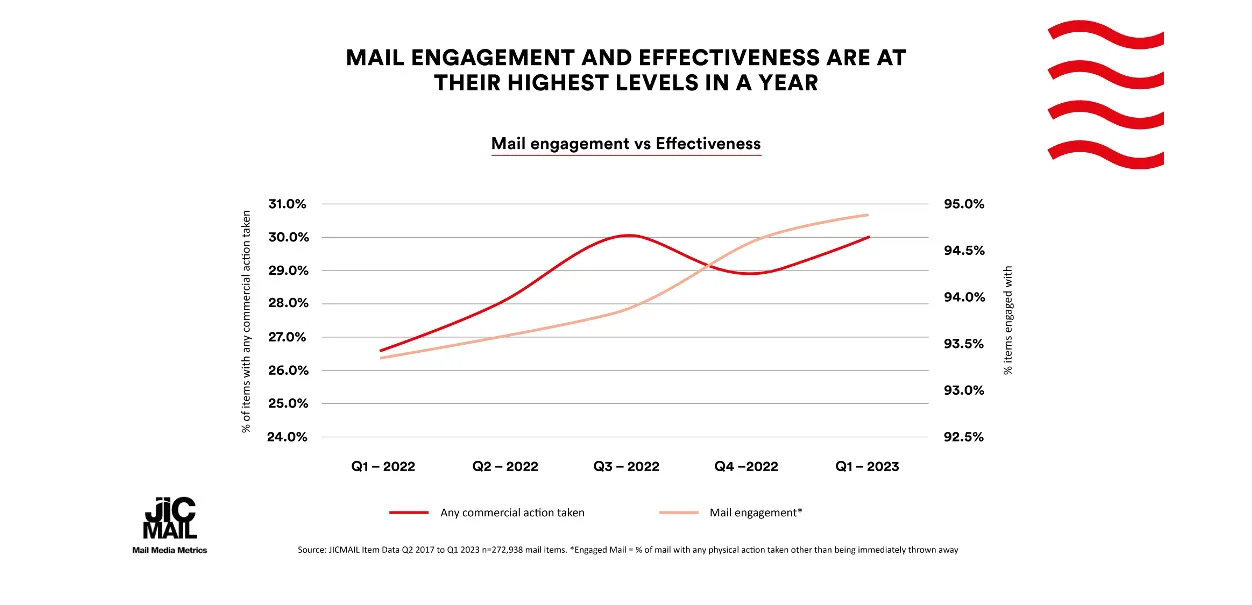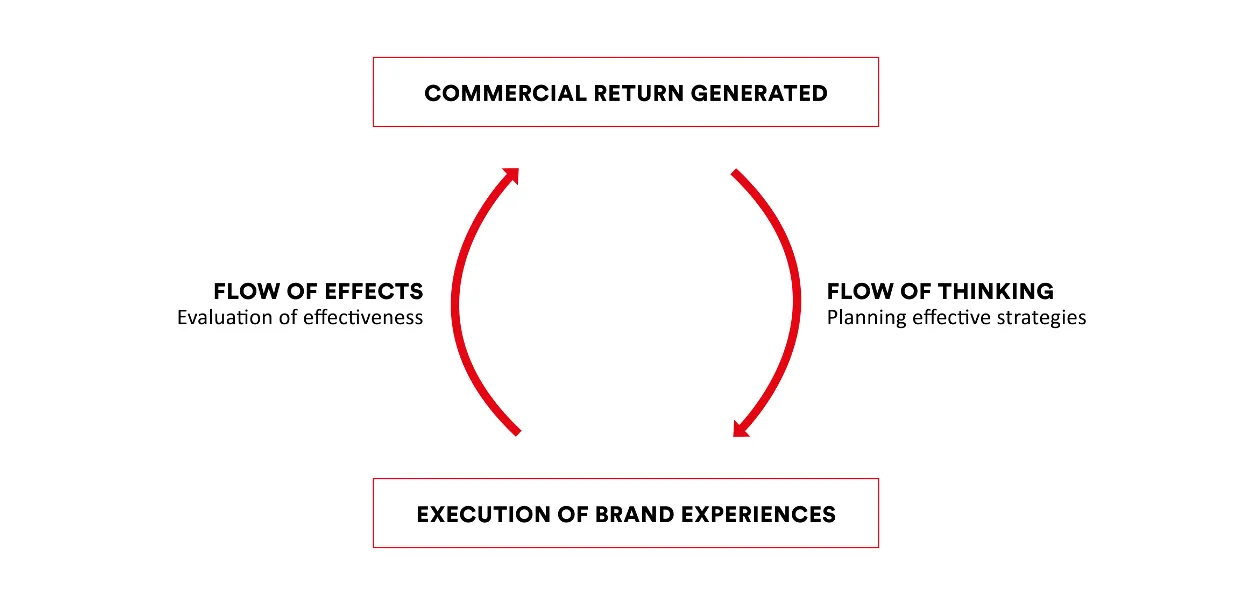The powerful effectiveness of mail marketing in 2023

It’s been a rollercoaster ride. Global Marketing spend plummeted in 2020 and then soared to unprecedented highs in 20211, outstripping all predictions2. Direct mail is showing signs of an even more dramatic turnaround. It’s been almost a decade of year-on-year decline, but now we’re at last seeing a return to growth. In the first 6 months of 2022, UK direct mail volumes grew 9.5% year-on-year3. After such a long period of decline the increase is still modest, and can’t be taken for granted. But it’s encouraging nevertheless.
There’s a growing recognition that with its physical, tactile nature, well-planned, well-executed ‘real’ mail can do things that email can’t. There’s also a growing recognition that with the aid of today’s technology, when it is used in conjunction with other channels, mail can amplify and strengthen overall campaign performance. Research by mail measurement body JICMAIL showed that online behaviour driven by mail increased by 70% during Covid4.
Marketing must be about Effectiveness
This is in a world where only 9% of sales emails are opened5.
But in the current economic climate all forms of marketing must earn their place at the table. Businesses increasingly look to marketers to justify the choice of channels used and prove the commercial value of their efforts.
It’s all about Effectiveness.
At The Effectiveness Partnership we talk a lot about something we call the Flow of Effects. It’s a simple concept, and perhaps deceptively so, but it’s enormously important for marketing today. It’s also surprisingly poorly understood.
Components of marketing effectiveness
Here’s how it works. You do something in the marketplace. It may be a mailing. It may be a social media post. It may be a TV ad. It may be an integrated combination of all of these and more. But you do that thing, and if it does what it is intended it will have an impact on how consumers think or feel about your brand. If it has enough of an effect, it will nudge consumers to behave a little differently. It might get more of them to buy your products. Or it might get your existing users to buy more. Either way, you should see a shift in market performance. And at the end of the day there will be an uplift – you hope - in company revenue figures reported in the boardroom. Think of it like one of those Newton’s Cradle executive toys, starting with a mailshot landing on a doormat and proceeding through a string of knock-on effects all the way to the chairman of the board announcing the annual profits. Importantly, each point can be observed, and each impact can be measured.

As I say, it’s a simple enough concept. Nevertheless, our research shows that 89% of all marketers say they find it sometimes or always challenging to establish the link between marketing activities and commercial returns6.
The key lies in two things: measurement and connection.
Why does measurement matter?
Measurement matters. If you can’t measure the impact of your activities, then you fall at the first hurdle when it comes to justifying your budget. Fortunately, direct mail has always been one of the most measurable of all forms of marketing. Back in the early days it was always possible to count how many coupons were clipped and redeemed, or how many calls made to the dedicated telephone line. Today, with growing opportunities for digital integration, the opportunities for interaction and the number of available metrics have increased exponentially. And the numbers we are getting from those measurements are impressive. We now know, for example, that 95% of all mail generates some form of physical interaction from consumers. We know that almost half (46%) remains ‘live’ and undiscarded in the home after 28 days. We know that the latest metrics for mail’s engagement and effectiveness are increasing7.

Making sense of your measurements
But the connection between measurements matters at least as much. Isolated, single-level measurements may be extremely useful for the job in hand or the task on the ground. But Effectiveness means being able to follow the flow of effects all the way upstream. This is where so many marketing efforts fall down. In the digital world, there are plenty of marketers who can give you chapter and verse on page impressions, clickthrough rates, likes, shares and dwell times, but who struggle to articulate just how many extra products in baskets this led to, or how much extra revenue that has brought in.
That’s why it’s so important to plan for effectiveness. Whether you’re talking direct mail or any other form of activity, effectiveness shouldn’t be something added on ad hoc or post hoc. It’s something that has to be built in, right from the start. We’ve built our business around helping our clients do this. It’s quite a detailed process, but I can share some of the basic principles.

The Effectiveness Flow Strategy
I talked about the flow of effects, and how the individual activities you execute in the marketplace can ladder up to a big change for your business. But to engineer your marketing activities so that they work in this way your strategy needs to be developed from the top down – from targets rather than from channels. We call this the Flow of Strategy. It’s about starting with the commercial and market performance targets, and then using them as the basis for working out in what way individual consumers will have to change their behaviour, and how your mailshot needs to change what they think or feel in order to achieve that.

Striving for effectiveness
We live in a world rushing to embrace digital and virtual technologies, and the newly-emerging metaverse. It is good and right to be excited about the potential these things can offer. But at the same time it is a mistake to write off the attractions of the real world, or the power of physical communications you can actually hold in your hand. A newer, smarter generation of marketers is pioneering ways to bring them together to multiply the possibilities of the physical and to take what is virtual and make it tangible and measurable. Which is why digitally-integrated, Effectiveness-driven direct mail looks set to become one of the hottest marketing tools of the 21st century.
The author, Gurdeep Puri is the Founding Partner of The Effectiveness Partnership, a transformation agency designed to help brands and agencies embed a culture of marketing effectiveness.
- UK Advertising’s Adspend Review: the Pandemic Effect, 2022, Advertising Association
- Expenditure Report, April 2022, Advertising Association/WARC
- https://adassoc.org.uk/our-work/uk-advertising-spend-forecast-to-rise-to-35bn-this-year/
- JICMAIL, 2021
- https://emailanalytics.com/37-email-statistics-that-matter-to-sales-professionals/
- LIONS, WARC and TEP State of Creative Effectiveness, 2022
- https://www.jicmail.org.uk/news/news-q1-2023-results-mail-engagement-and-effectiveness-reached-their-highest-level-in-a-year/





